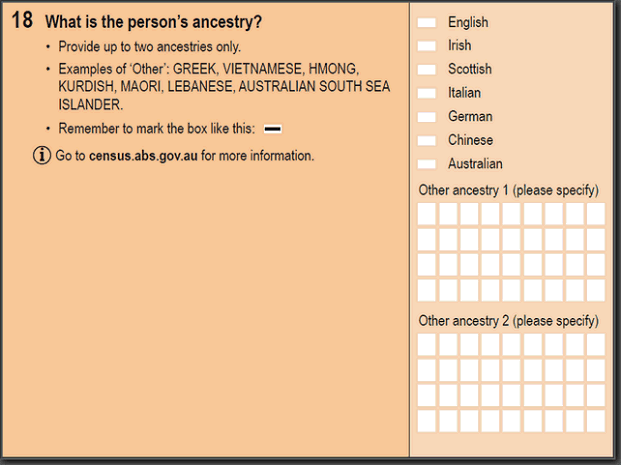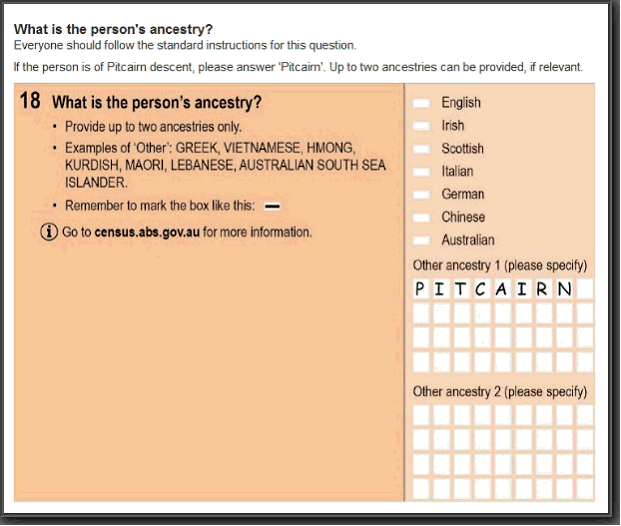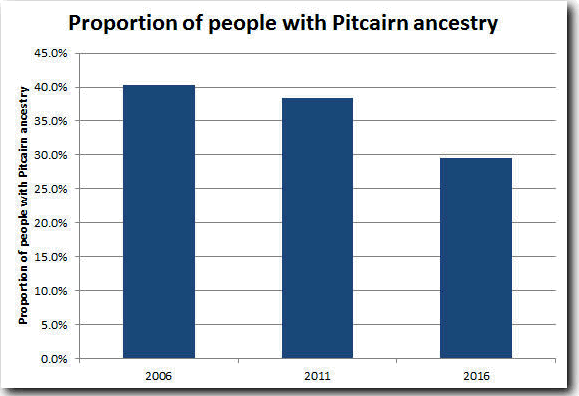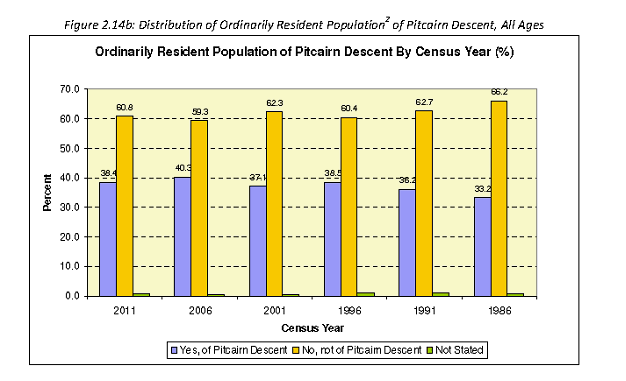Understanding ancestry in the Norfolk Island population
Data usage note
Ancestry data reported for Norfolk Island from the 2016 Census is not comparable with Pitcairn ancestry data reported from Norfolk Island Censuses (2011 and prior). The ABS cautions against conclusions made on the basis of comparing the two. The following article explains the reasons why.
Differences between questions on ancestry in the 2016 Census and the 2011 Norfolk Island Census
The 2011 Norfolk Island Census asked one question relating to ancestry, specifically whether a person was of Pitcairn descent or not. This image shows the question as asked in the 2011 Norfolk Island Census.

In contrast, the 2016 Census asked respondents to identify up to two ancestries only, using either the tick box list provided or by writing in the text fields. The image below shows the question on the 2016 Census form.

The two questions are fundamentally different in their format and design, and their intent. While the 2011 Norfolk Island Census aimed to capture information specifically about Pitcairn ancestry, the 2016 Census aimed to capture up to two ancestries that the person most affiliates with. For example, a respondent in the 2016 Census may have Pitcairn ancestry but indicate English and Australian instead if they feel more strongly associated with these ancestries. In the 2011 Norfolk Island Census it is likely that this person would have responded ‘Yes’ to the question of Pitcairn descent.
Pitcairn ancestry was identified in the 2011 Norfolk Island Census through a respondent simply checking the ‘Yes’ box, whereas Pitcairn ancestry in the 2016 Census was identified by a written response in either the first response or second response text fields (as instructed in the information sheet provided to each person enumerated on Norfolk Island, see image below). The requirements from the respondent between the two types of questions are vastly different and therefore the results from these two Censuses in relation to Pitcairn are not comparable.
The enumeration of Norfolk Island was an area of special attention for the ABS and specifically for questions relating to culture. An information sheet was provided to each person on Norfolk Island that gave instructions about how to respond using Norfolk Island specific examples. The image below shows the instruction given for the Ancestry question.
 Image: 2016 Household Paper Form - Question 18. What is the person's ancestry? If the person is of Pitcairn descent, please answer 'Pitcairn'.
Image: 2016 Household Paper Form - Question 18. What is the person's ancestry? If the person is of Pitcairn descent, please answer 'Pitcairn'.
Comparison of data from the 2016 Census with previous Norfolk Island Censuses
An addendum 2 to the 2011 Norfolk Island Census report 3 showed that the proportion of the Norfolk Island population who reported Pitcairn descent had reduced from 40.3% in 2006 to 38.4% in 2011. The 2016 Census showed that 29.6% of usual residents on Norfolk Island who provided a response to the ancestry question indicated that they had Pitcairn ancestry. If recent arrivals (persons born overseas arriving between 2012 and 2016) and recent births (persons aged under five years old) are excluded from the calculation, the proportion of people stating a Pitcairn ancestry is 30.8%.

Source: 2006 and 2011 data from Addendum to Norfolk Island 2011 Census report.
2016 data from 2016 Census of Population and Housing.
A lower incidence of Pitcairn response in the 2016 Census may be an outcome of not having a direct prompt for Pitcairn on the Census form, as was the case in the previous Norfolk Island Censuses.
It may also be partly reflective of increasing numbers of people on Norfolk Island of non-Pitcairn descent and decreasing numbers of those with Pitcairn descent (either through migration or death), as suggested in the 2011 Norfolk Island Census report. The 2016 Census showed 262 responses of Pitcairn ancestry for people usually resident in other states and territories of Australia (notably Queensland and New South Wales), which may support a theory of increased migration out of Norfolk Island of people of Pitcairn descent.
In the 2016 Census, while responses of ‘Pitcairn’ to the Ancestry question were coded to ‘Pitcairn’, responses of ‘Norfolk Island’ (and variations) were coded to ‘Australian’. This is consistent with the coding practices of previous Australian Censuses, however will be reviewed for the 2021 Census to determine how these responses may be otherwise classified. There are approximately 120 usual residents of Norfolk Island who indicated that they had ‘Norfolk Island’ ancestry (approximately 7% of Norfolk Island Usual Residents). Of these 120 persons, approximately 30 persons also indicated that they had Pitcairn ancestry and are included in the count of those with Pitcairn ancestry.
Exploring 2016 Census Ancestry Responses
Standard Census products for the 2016 Census show that the most common ancestries 1 for usual residents of Norfolk Island (Statistical Area Level 3) were Australian (22.8%), English (22.4%), Pitcairn (20.0%), Scottish (6.0%), and Irish (5.2%). This means that, for example, 20.0% of all ancestries reported were Pitcairn, with some people reporting two ancestries and some people reporting one.
Almost 54% of usual residents of Norfolk Island indicated only one response to ancestry, with just 14.8% providing a Pitcairn only response.
Just over 40% of usual residents of Norfolk Island provided two responses, including 12.4% that provided a Pitcairn response in addition to another response.
Ancestry Information from previous Norfolk Island Censuses
Excerpt from the Norfolk Island 2011 Census Report
3:
As in previous Norfolk Island Censuses, the 2011 Census again asked a question relating to Pitcairn descent. In comparing the responses between census periods of between 1986 and 2006, the ratio of a “yes, of Pitcairn descent” and “no, not of Pitcairn descent” response is around 1:1. For the 2011 Census, the ratio has slightly changed to 1:1.5. Thus for two persons of Pitcairn descent, there are three persons of non Pitcairn descent in the ordinarily resident population on Norfolk Island. This may imply that persons of Pitcairn descent may have relocated temporarily or migrated and that the increased number of persons of non Pitcairn descent is a contributing factor in the ratio.
Excerpt from the Addendum to the Norfolk Island 2011 Census Report
2:
In ensuring that the 2011 Census figures relating to the “ordinarily resident population” are comparable to the previous censuses, all TEP holders and Others (itinerant population) are added to the “permanent population” and none are assumed to be of Pitcairn descent. Figure 2.14b indicates that, at the time of the 2011 Census, 38.4 percent of ordinarily resident population were of Pitcairn descent and 60.8 percent were not of Pitcairn descent. As in figure 2.14a, the responses between 1986 and 2011 censuses remain consistent with minimal differences in proportions.

Source: Addendum to Norfolk Island 2011 Census report.
Footnotes:
1. Respondents had the option of reporting two ancestries on their Census form, and this is captured by the Ancestry Multi Response (ANCP) variable used in this table. Calculated percentages represent a proportion of total reported ancestry responses in Norfolk Island (Statistical Area Level 3), and therefore the total responses count will not equal the persons count.
2. Norfolk Island Regional Council. (2012).
Addendum to the Norfolk Island 2011 Census Report. Retrieved from:
http://www.norfolkisland.gov.nf/sites/default/files/public/documents/ANIReports/Census/Census_2011_Addendum%2817.01.12%29.pdf
3. Norfolk Island Regional Council. (2011).
Norfolk Island Census of Population and Housing 9 August 2011. Retrieved from:
http://www.norfolkisland.gov.nf/sites/default/files/public/documents/ANIReports/Census/Census_2011.pdf
 Print Page
Print Page
 Print All
Print All